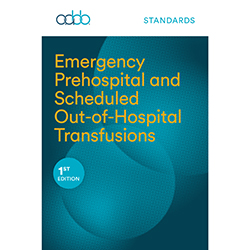
The Standards for Emergency Prehospital and Scheduled Out-of-Hospital Transfusions will maintain and enhance the quality and safety of services provided by prehospital transfusion services (EMS services) and out-of-hospital transfusion services (including infusion centers, nursing homes, long-term care facilities, hospice or home care settings), and provide the basis for accreditation by AABB.
Current edition: 1st edition
Effective date: Jul 1, 2025
Revision cycle: 24 months
The print version, portal version, printed guidance and bundle packages of the Standards for Emergency Prehospital and Scheduled Out-of-Hospital Transfusions are available for purchase
The practice of transfusing blood products outside of the hospital setting is growing, with prehospital transfusion especially expanding to provide life-saving care at the point of injury. AABB's Emergency Prehospital and Scheduled Out-of-Hospital Transfusions and associated Accreditation activities were developed in response to demand and shifts in the point of transfusion care, for which quality and safety must be maintained.
With our 65-year history in Accreditation for the blood and biotherapies field, AABB is uniquely positioned to develop Standards and a related accreditation program. Standards and accreditation in this area build on the concepts in the Standards for Blood Banks and Transfusion Services, currently in its 34th edition.
Emergency Prehospital and Scheduled Out-of-Hospital Transfusions Standards and Accreditation ensure that patients receive optimal care and signal to blood suppliers that providers are compliant with AABB Standards.
AABB Accreditation for Emergency Prehospital and Scheduled Out-of-Hospital Transfusions will: